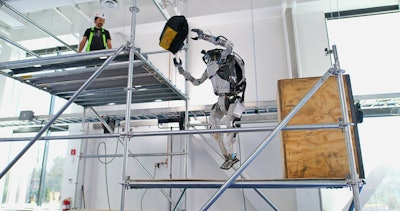
The company that brought you Spot the robotic construction dog has now leaped forward in a new video showing Atlas the humanoid bringing tools to a worker on a scaffold.
The two-legged Atlas is a research project by Boston Dynamics, designed to give a robot humanlike – and even, superhuman – maneuverability.
In the video below, Atlas fetches a 17-pound tool bag for a worker on a scaffold and performs some impressive acrobatics and feats along the way. The company says Atlas, which has been shown in previous videos performing parkour and dancing, can now “lift, carry and throw larger, heavier objects than ever before.”
Boston Dynamics uses “model predictive control” for Atlas’ operation. With it, models of the robot’s dynamics predict how it will move and then it makes adjustments. The model “searches over possible actions it can take now and in the near future to best achieve the set task,” the company says. Depth sensors generate point clouds to detect its surroundings.
The new Atlas video demonstrates the company’s ability to expand model predictive control to more complex tasks. The model now considers “the motion of every joint in the robot, the momentum of every link in the robot and the forces the robot applies on an object that it is carrying or throwing.”
“With this more powerful model,” the company says, “Atlas can consider more interesting actions like carrying a heavy object while maintaining balance, simultaneously jumping through the air while performing a throw and tucking the legs in just enough to nail the landing of our ‘sick trick.’”
{Related Content: Trimble partners with Boston Dynamics to bring enhanced Spot robot to jobsites}
Atlas consists of 28 hydraulic joints that are powered by a custom battery, a compact hydraulic power unit and valves. It can travel at a speed of up to 8.2 feet per second. It consists of 3D-printed parts, weighs 196 pounds and is about 5 feet tall.
Boston Dynamics envisions robots performing a variety of tasks such as picking up heavy objects and placing them precisely where they are needed. Model predictive control chooses the forces acting between the robot and the object and predicts those forces’ effect. For example, the controller can plan to shift the robot’s weight back in anticipation of it lifting a heavy object. And when lifting does not go as planned, the controller uses the inertia of the object being held to improve the robot’s balance.
Boston Dynamics engineers also show off Atlas’ athleticism with a twisting dismount “sick trick” at the conclusion of the video.
“The sick trick is the most dynamic behavior we’ve ever achieved on Atlas, and it is right at the limits of what the robot can do today,” the company says.
The ultimate goal of the research project is to get Atlas able to perform high-level tasks for work outside of the lab. In the meantime, the company says it will continue to explore Atlas’ capabilities.
“The most exciting part about finding the limits of the robot, however, is imagining how we might still exceed those limits next time,” Boston Dynamics says. “We don't know today how we will make Atlas jump higher or spin faster, but we might find out tomorrow.”













